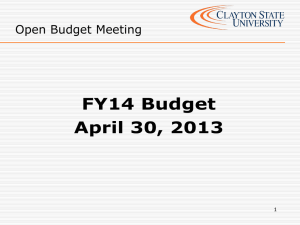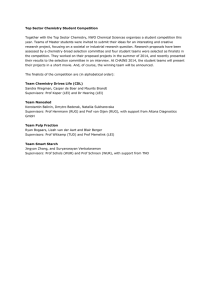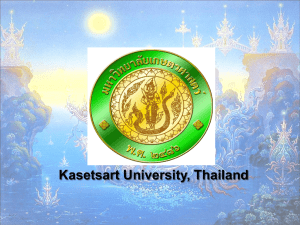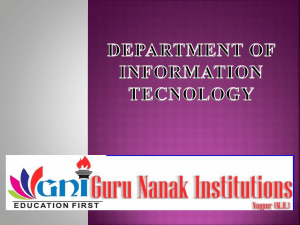What is Organization Development?
advertisement
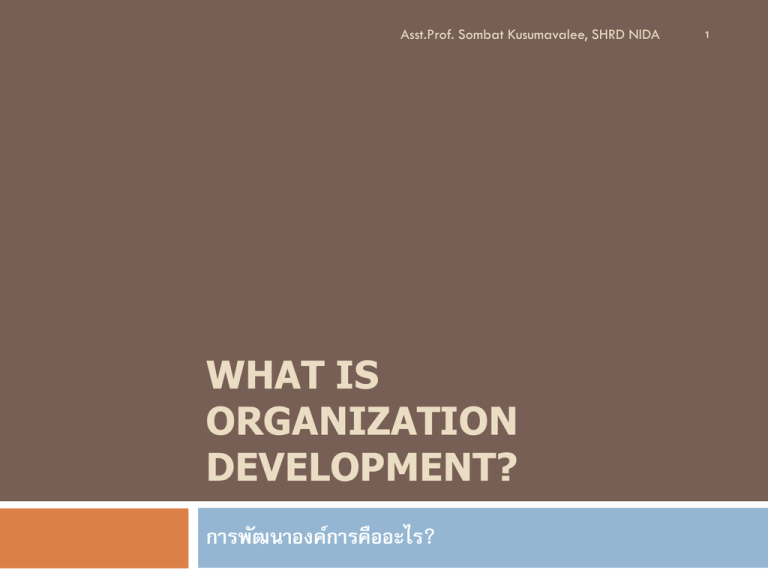
Asst.Prof. Sombat Kusumavalee, SHRD NIDA WHAT IS ORGANIZATION DEVELOPMENT? การพัฒนาองค์การคืออะไร? 1 2 Concise history of OD From Classical OD to Modern Organization Change and Transformation Asst.Prof. Sombat Kusumavalee, SHRD NIDA จุดเริม ่ ต ้นของการตืน ่ ตัวในวิชาการด ้าน การพัฒนาองค์การ 3 ความเคลือ ่ นไหวในชว่ งทศวรรษที่ 1950 และ 1960 มีการพัฒนาองค์ความรู ้ทางด ้านการพัฒนาองค์การ ิ ธิผลของ เพือ ่ ให ้เป็ นเครือ ่ งมือทีจ ่ ะชว่ ยเพิม ่ พูนประสท องค์กร พร ้อมทัง้ เป็ นเครือ ่ งมือทีจ ่ ะชว่ ยปรับปรุง ิ ภายในองค์การ คุณภาพชวี ต ิ การทางานของสมาชก Asst.Prof. Sombat Kusumavalee, SHRD NIDA Brief history of OD (1) 4 The late 1950s and early 1960s OD =rooted in the behavioral sciences to created planned change in organizations. Early OD practitioners = influenced by ideas and normative values based in social psychology and humanistic psychology (Lewin, Lippitt, Maslow, McGregor, Argyris) ‘Organization effectiveness’ Asst.Prof. Sombat Kusumavalee, SHRD NIDA Humanistic Psychology 5 Believes that humans have an intrinsic need for psychological growth. Organizational structures or practices that limit opportunities for personal growth are ultimately harmful to the organization. The intervention designed to limit opportunities for personal growth is not truly an OD intervention Asst.Prof. Sombat Kusumavalee, SHRD NIDA WW II and OD 6 เหตุผลสาคัญประการหนึง่ ทีท ่ าให ้มีพัฒนาการของ การพัฒนาองค์การอย่างมากในชว่ งนี้ ก็คอ ื ผลพวง จากการเกิดสงครามโลกครงที ั้ ส ่ อง สงครามโลกครัง้ ทีส ่ องได ้ก่อให ้เกิดการเจริญเติบโต ก ้าวหน ้าอย่างมหาศาลในด ้านความรู ้ การวิจัย และ ทฤษฎีทเี่ กีย ่ วกับองค์การ ไม่วา่ จะเป็ นการวิจัยในด ้าน พฤติกรรมองค์การ ทฤษฎีองค์การ การบริหารจัดการ การจัดการทรัพยากรมนุษย์ และ การจัดการเชงิ กล ยุทธ Asst.Prof. Sombat Kusumavalee, SHRD NIDA ั พันธ์” “ขบวนการเคลือ ่ นไหวด ้านมนุษย์สม (Human Relations Movement) 7 ึ ษาวิจัยเกีย มีความเคลือ ่ นไหวในด ้านการศก ่ วกับพฤติกรรม ั พันธ์ภายในองค์การเป็ นอย่างมาก มี มนุษย์และมนุษย์สม ความพยายามดึงเอาองค์ความรู ้ ตัวแบบ เทคนิควิธก ี าร กล ้ ฒนาศาสตร์ทเี่ กีย ยุทธจากสาขาวิชาต่างๆ มาใชพั ่ วกับ องค์การ รวมทัง้ การประยุกต์เอาศาสตร์และวิทยาการของ ้ งในทางปฏิบต ทฤษฎีองค์การไปใชจริ ั ิ โดยเน ้นไปที่ ึ ษาถึงแนวโน ้มพลวัตรความเปลีย ั ซอน ้ การศก ่ นแปลงทีซ ่ บ มากขึน ้ (Complex change dynamics) แล ้วจึงประยุกต์ เอาวิทยาการด ้านต่างๆ มาทาการเปลีย ่ นแปลงระบบมนุษย์ (Human systems) อย่างมีแผนการ Asst.Prof. Sombat Kusumavalee, SHRD NIDA นักคิดคนสาคัญ 8 ดักลาส แม๊คเกรเกอร์ (Douglas McGregor) อีรค ิ ทริสต์ (Eric Trist) เคริท เลวิน (Kurt Lewin) ริชาร์ด เบ๊คฮาร์ด (Richard Beckhard) ฯลฯ ร่วมกัน ขับเคลือ ่ นขบวนการ “คุณภาพชวี ต ิ ในการทางาน” (Quality of Working Life movement - QWL) Asst.Prof. Sombat Kusumavalee, SHRD NIDA ่ งทศวรรษที่ 1950 ในชว 9 แม๊คเกรเกอร์และเบ๊คฮาร์ด ร่วมกันเป็ นทีป ่ รึกษา ให ้กับบริษัท General Mills แล ้วจึงได ้สร ้างคาว่า “การพ ัฒนาองค์การ” (Organization Development) ขึน ้ มา ื่ สาแดงให ้เพือ เพือ ่ สอ ่ นร่วมวงการได ้เห็นถึงความ พยายามของพวกเขาทีจ ่ ะก่อให ้เกิดการ เปลีย ่ นแปลงจากข้างล่างขึน ้ มาอย่างสร ้างสรรค์ (Innovative bottoms-up change effort) Asst.Prof. Sombat Kusumavalee, SHRD NIDA ่ งแรกของวิชาการด้านการพ ัฒนาองค์การ ชว 10 มีแนวคิดและกิจกรรมทีม ่ งุ่ เน ้นไปที่ “ด ้านของมนุษย์” ่ เรือ (Human side) ขององค์การ เชน ่ งของ คน ั พันธ์ นโยบาย กระบวนการ ขัน ความสม ้ ตอน วัฒนธรรม บรรทัดฐาน และการออกแบบองค์การ เป็ นต ้น Asst.Prof. Sombat Kusumavalee, SHRD NIDA Organization as Human Systems 11 นักคิดและนักปฏิบต ั ก ิ ารด ้านการพัฒนาองค์การมักจะ มององค์การว่าเปรียบเสมือน “ระบบมนุษย์” (Human systems) ทีถ ่ ก ู สร ้างขึน ้ มาเพือ ่ บรรลุ เป้ าหมายบางประการ โดยมีการ “ปรับปรุง” (Improvement) ภายในองค์การซงึ่ เกิดขึน ้ ด ้วย กระบวนการการเปลีย ่ นแปลงอย่างมีแผนการ (Planned change) ่ นีจ ทัง้ นี้ กระบวนการเชน ้ ะสาเร็จได ้ก็ด ้วยวิธก ี ารการ เข ้าไปแทรกแซง (Intervention) ด ้วยกิจกรรมและ เครือ ่ งมือทีไ่ ด ้รับการออกแบบและพัฒนาอย่าง หลากหลาย Asst.Prof. Sombat Kusumavalee, SHRD NIDA OD is… 12 …a top management-supported, long-range effort to improve an organization’s problemsolving and collaborative diagnosis and management of organizational culture – with special emphasis on formal work-team, temporary team, and intergroup culture – with the assistance of a consultant – facilitator and the use of theory and technology of applied behavioural research, including action research (French and Bell, 1990: 17). Asst.Prof. Sombat Kusumavalee, SHRD NIDA …a set of behavioural science-based theories, values, strategies, and techniques aimed at the planned change of the organizational work setting for the purpose of enhancing individual development and improving organizational performance, through the alteration of organizational members’s on-the-job behaviours (Porras&Robertson, 1992). 13 Asst.Prof. Sombat Kusumavalee, SHRD NIDA Organizational Development 14 Organizational development is a series of techniques and methods that managers can use in their action research program to increase the adaptability of their organization. (George & Jones, 2007) Asst.Prof. Sombat Kusumavalee, SHRD NIDA Action Research 15 Action research is a strategy for generating and acquiring knowledge that managers can use to define an organization’s desired future state and to plan a change program that allows the organization to reach that state. Asst.Prof. Sombat Kusumavalee, SHRD NIDA Organization development is an effort (1) planned, (2) organization-wide, and (3) managed from the top, to (4) increase organization effectiveness and health through (5) planned interventions in the organization’s processes,” using behavioral-science knowledge. (Beckhard, 1969) 16 Asst.Prof. Sombat Kusumavalee, SHRD NIDA ชุดรายการคุณล ักษณะเด่นของการพ ัฒนาองค์การ (Wendell, Cecil and Bell, 1999) 17 การพัฒนาองค์การมีจุดเน้นที่ “วัฒนธรรมและกระบวนการ” การพัฒนาองค์การจะสนับสนุนเป็ นพิเศษในการทางานร่วมกัน (Collaboration) ระหว่างผูน้ ากับสมาชิกขององค์การในการบริหารจัดการ วัฒนธรรมและกระบวนการ ทีมงานทุกประเภทมีความสาคัญเป็ นอย่างยิง่ ต่อการบรรลุผลสัมฤทธิ ์ภารกิจ และยังถือเป็ นจุดมุง่ หมายสาคัญสาหรับกิจกรรมด้านการพัฒนาองค์การ การพัฒนาองค์การมีจุดเน้นที่ “ด้านของมนุษย์และสังคม” (Human and social side) ขององค์กร แต่อย่างไรก็ตาม ในการดาเนินการก็ยอ่ มเข้าไป แทรกแซงส่งผลใน “ด้านของเทคโนโลยีและโครงสร้าง” (Technological and structural sides) ด้วย Asst.Prof. Sombat Kusumavalee, SHRD NIDA ชุดรายการคุณล ักษณะเด่นของการพ ัฒนาองค์การ (Wendell, Cecil and Bell, 1999) 18 การทีบ่ ุคลากรทุกระดับขององค์การได้เข้ามามีสว่ นร่วม (Participation) และ มีสว่ นเกีย่ วพัน (Involvement) อยูใ่ นกระบวนการแก้ไขปญั หาและการ ตัดสินใจถือเป็ นส่วนทีส่ าคัญมากสาหรับการพัฒนาองค์การ การพัฒนาองค์การมุง่ เน้นทีก่ ารเปลีย่ นแปลงระบบโดยองค์รวม (Total system change) และมององค์กรว่าเป็ นระบบทางสังคมทีม่ คี วามซับซ้อน (Complex social systems) นักพัฒนาองค์การแสดงบทบาทเป็ น “ผูเ้ อือ้ อานวย” (Facilitators) นัก ประสานความร่วมมือ (Collaborators) และเป็ นทีเ่ รียนรูร้ ว่ ม (Co-learners) ไปกับระบบของหน่วยงานผูร้ บั บริการ Asst.Prof. Sombat Kusumavalee, SHRD NIDA ชุดรายการคุณล ักษณะเด่นของการพ ัฒนาองค์การ (Wendell, Cecil and Bell, 1999) 19 เป้ าหมายใหญ่ ข องการพัฒ นาองค์ ก ารคือ การท าให้ ร ะบบของหน่ ว ยงาน ั หาได้ด้วยตนเอง โดยการสอนทัก ษะและ ผู้รบั บริการ สามารถที่จะแก้ไขป ญ ความรูเ้ กีย่ วกับการเรียนรูอ้ ย่างต่อเนื่อง (Continuous learning) ผ่านวิธกี ารแห่ง การวิเคราะห์ตนเอง (Self-analytical) การพัฒนาองค์การมองการปรับปรุง องค์กรว่าเป็ นเสมือนกระบวนการที่ดาเนินการอย่างต่อเนื่องภายในบริบทของ สภาพแวดล้อมทีม่ กี ารเปลีย่ นแปลงอยูต่ ลอดเวลา การพัฒนาองค์การยึด ถือตัวแบบการวิจ ย ั เชิงปฏิบตั กิ าร (Action research model) ทีเ่ น้นการมีสว่ นร่วมอย่างเข้มข้นโดยสมาชิกของหน่วยงานผูร้ บั บริการ การพัฒนาองค์การมีทศ ั นะแบบ “พัฒนานิยม” (Developmental view) กล่าวคือ แสวงหาแนวทางที่จ ะก่ อ ให้เ กิด การปรับ ปรุ ง ที่ดีข้นึ ทัง้ ในแง่ข ององค์ก รและ บุคลากรภายในองค์กร ความพยายามทีจ่ ะสร้างสถานการณ์แบบชนะด้วยกัน ทัง้ สองฝา่ ย (Win-Win) ถือเป็ นแนวปฏิบตั มิ าตรฐานในโปรแกรมการพัฒนาองค์กร Asst.Prof. Sombat Kusumavalee, SHRD NIDA ่ งทศวรรษที่ 1980 จุดเปลีย ่ นในชว 20 การเปลีย ่ นผันอย่างมากของบริบทโลก ไม่วา่ จะเป็ น การพลิกผันเมือง การเปลีย ่ นแปลงทางเศรษฐกิจหรือ การปฏิวัตท ิ างเทคโนโลยี ทาให ้เกิดแนวคิดเกีย ่ วกับ โปรแกรมการเปลีย ่ นแปลงทีจ ่ ะต ้องถูกออกแบบให ้มี การเปลีย ่ นแปลงขนานใหญ่ (Large scale) ทีเ่ น ้นให ้มี การเปลีย ่ นแปลงอย่างลึกซงึ้ ในระดับพืน ้ ฐานอย่างถึง รากถึงโคน (Radical and fundamental change) เกิดแนวคิดการเปลีย ่ นแปลงถึงระดับ “การโยกกระบวน ทัศน์” (Paradigm shift) ของการพัฒนาองค์การไปสู่ คาใหม่ทเี่ รียกว่า “การแปลงรูปองค์กร” (Organization transformation - OT) Asst.Prof. Sombat Kusumavalee, SHRD NIDA ด้วยสภาวะการแข่งขันที่เข้มข้นรุนแรงขึ้ น ความเรียกร้องต้องการของลูกค้าที่ มีต่อสินค้าและ บริ ก าร การปฏิ ว ัติ ท างเทคโนโลยีส ารสนเทศ การล่ ม สลายของลัท ธิ ค อมมิ ว นิ ส ต์ และ กระบวนการเศรษฐกิจเสรีนิยม ในนามของโลกาภิวฒ ั น์ ล้วนเป็ นเหตุให้องค์กรต้องทาการ เปลี่ยนแปลง – อย่างรวดเร็ว – จึงจะอยู่รอดได้ แนวทาง แนวปฏิบัติ และระบบความคิด ความเชื่อแบบเก่าๆ ถือว่าไม่ดีพอ ไม่เท่าทันกับการเปลี่ยนแปลงได้อีกต่อไปแล้ว องค์กรต้อง ถูก “แปลงรูป ” มิ ใ ช่ แ ค่ “ปะผุ ” ไปวัน ๆ กระบวนทัศ น์ ก็ จ ะต้อ ง “เปลี่ ย นใหม่ ” มิ ใ ช่ แ ค่ “ปรั บ เปลี่ ย น” เท่ า นั้ น นั ก พั ฒ นาองค์ ก รจึ ง ได้พั ฒ นา “เครื่ อ งมื อ และกิ จ กรรม” (Interventions) เพื่อเอื้ ออานวยการจัดการเชิงกลยุทธโดยผูบ้ ริหารระดับสูงขององค์กร ให้ส ามารถเปลี่ ย นแปลงองค์ก รให้เ กิ ด การท างานที่ “เร็ ว ขึ้ น ดี ข้ ึ น ถู ก ลง” (Faster, Better, Cheaper) 21 Asst.Prof. Sombat Kusumavalee, SHRD NIDA Turning point of OD 22 In the 1980s, major management consultants = include ‘reengineering’ or ‘business process reengineering’ Led to new practices areas as ‘change management’ Reengineering and change management were virtually synonymous. Is reengineering an OD intervention? Asst.Prof. Sombat Kusumavalee, SHRD NIDA Change management 23 Assumption = specific changes can be identified and implemented using planning and project management techniques Employing participative process = to secure buy-in and support for change Needed change = identified, planned and led by managers and executives using consultants as agents and resources to help direct or steer the change(s). Intend to advance the competitive, economic and financial well-being of organization. Change management = ‘engineering organizations for economic gain’. Asst.Prof. Sombat Kusumavalee, SHRD NIDA Comparison of Change Management and Organization Development 24 Change Approach Emphasis on Methods Dominant Values Management of Change as Change Management Outcomes Elite processes Economic Engineering and directing Organization Development Processes Participatory processes Humanistic Facilitation and coaching Asst.Prof. Sombat Kusumavalee, SHRD NIDA Language and Values of Social Psychology and Humanism vs. Economics and Business Dimension 25 Social Psychology and Humanism Economics and Business Highest value Human Development Financial Return Instrumental agent Awareness Money and Resources Image Self-actualization The bottom line Location of values in action Inner self The marketplace Icon Enlightened and empowered self Entrepreneur and business executive Theme The Individual: Freedom Business and markets: Dignity Empowerment Emotions Spirit Holistic integration Asst.Prof. Sombat Kusumavalee, SHRD NIDA Competitive strategy Profit and Loss Productivity ROI Efficiency use of resources Economic wealth Positioning OD 26 Modern OT Businessoriented Humanism Classical OD Participatory Elitism Asst.Prof. Sombat Kusumavalee, SHRD NIDA ‘Positioning OD’ จุดเน้นทีแ ่ ตกต่างก ันของสองสาน ักทฤษฎีพ ัฒนาองค์การ 27 Businessoriented Modern OT Participatory Elitism Classical OD Humanism Asst.Prof. Sombat Kusumavalee, SHRD NIDA OD:a Comprehensive viewpoint 28 OD is a comprehensive process of planned improvement in overall functioning of an organisation. It deals with, and attempts to improve, any aspect of the organisation that needs fixing: it is not limited to psychological, behavioural, social, or cultural aspects of the organisation: it is comprehensive. Asst.Prof. Sombat Kusumavalee, SHRD NIDA การพ ัฒนาองค์การคืออะไร? 29 กระบวนการของการปรับปรุง เปลีย่ นแปลงองค์กรอย่างมีแผนการ (Planned change) และต้องใช้ เวลาระยะยาว (Long-range effort) เป็ นการมุง่ มองทุกๆส่วนขององค์กร ทีต่ อ้ งการการปรับปรุงแก้ไขอย่าง เหมาะสม (Organization-wide) ได้รบั การสนับสนุนและขับเคลือ่ น จากผูบ้ ริหารระดับสูง (Managed by the top) (Management support) มุง่ ให้องค์กรมีประสิทธิผลในการ ทางาน (Effectiveness) และมีสขุ ภาวะทีด่ ี (Healthy) = HPO มีการเข้าดาเนินการอย่างมีแผนการ (Planned interventions) ใช้องค์ความรูแ้ บบ “สหวิทยาการ” (Interdisciplinary) อาจต้องใช้ที่ปรึกษา – ภายใน/ ภายนอก” เป็ นตัวช่วย Asst.Prof. Sombat Kusumavalee, SHRD NIDA OD 30 ไม่ใช่แค่ “ทำอะไรก็ได้ เพื่อให้ องค์กรดูดีข้ นึ ” แต่หมำยถึง “กระบวนกำรเปลี่ยนแปลงที่ถูกออกแบบขึ้นมำเพื่อ ก่อให้ เกิดผลลัพธ์ท่พี ึงประสงค์” OD จึงต้ องมีท้ง ั กำร “คิดสะท้ อนภำพองค์กร” (organizational reflection), “กำรวำงแผน วิเครำะห์และปรับปรุงองค์กรอย่ำงเป็ นระบบ” (system improvement, planning, and self-analysis). Asst.Prof. Sombat Kusumavalee, SHRD NIDA It is usually carried out by “change agents” who may be managers or key people within the organisation, with or without the assistance of specialised resource people, including consultants. 31 Asst.Prof. Sombat Kusumavalee, SHRD NIDA HR’s dual role in OD Change agents: initiate and lead the organizational changes that a company must make to remain competitive in the face of major business shifts. Change facilitators: support change initiatives launched by others in organization. What HR professional-turned changeagents-and-facilitators look like in action? Scouts: scan the external and internal business landscape to identify their company’s strengths and weaknesses related to people, process, structure, and technologies; assess potential threats and the company’s ability to overcome those threats; and spot opportunities to improve operations and put the right talent in place to support the company’s business strategy. What HR professional-turned changeagents-and-facilitators look like in action? (2) Chess masters: Identify and coach individuals who can best lead change efforts; Develop and communicate key messages supporting change champions; and deploy human resources to best influence the outcome of a change initiatives. What HR professional-turned changeagents-and-facilitators look like in action? (3) Cartographers: Provide a “road map” describing the steps, tools, and techniques necessary for the company to navigate major change, including how the company will address barriers to a change initiatives. What HR professional-turned changeagents-and-facilitators look like in action? (4) Architects: Rethink the design of systems and processes for managing human performance, such as job-classification systems, compensation and incentive systems, training and development programs, and informal recognition system. ทีป ่ รึกษา “ภายใน” ก ับ “ภายนอก” ใชใ้ ครดี? 37 ข้อดี ทีป ่ รึกษา ภายนอก ทีป ่ รึกษา ภายใน ื่ ถือในฐานะผู ้เชย ี่ วชาญ ความน่าเชอ ไม่มป ี ระวัตใิ นทางลบกับคนในองค์กร เป็ นคนกลางทีม ่ าจากข ้างนอก มีประสบการณ์ทห ี่ ลากหลายจากภายนอก เป็ นคนวงใน รู ้จักคน วัฒนธรรม และจารีตขององค์กร ั พันธ์เชงิ ลึกกับคนในองค์กร มีความสม รู ้จักธุรกิจ ประวัตศ ิ าสตร์ เทคโนโลยีของ องค์กร พร ้อมเรือ ่ งเวลาและการเข ้าถึงสาหรับคน ในองค์กร ข้อด้อย ถูกมองว่าเป็ นคนนอก ขาดความรู ้ในองค์กร มักจะมีปัญหาเรือ ่ ง เวลา และ การ เข ้าถึง ่ ู ้รู ้จริงในเรือ มักจะถูกมองว่าไม่ใชผ ่ ง OD อาจจะมีข ้อมูลและประวัตใ ิ นทางลบใน องค์กร อาจจะมีประสบการณ์น ้อยในด ้าน OD ไม่คอ ่ ยมีประสบการณ์กบ ั องค์กรอืน ่ ๆ มักจะไม่มค ี วามเป็ นกลาง Dr.Sombat Kusumavalee, SHRD NIDA 38 OD practitioners = Interventionists ที่ปรึกษาด้านการพัฒนาทรัพยากรมนุ ษย์คือ “นักแทรกแซง” Asst.Prof. Sombat Kusumavalee, SHRD NIDA

